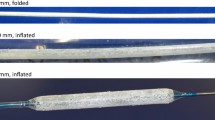Abstract
Restenosis remains the major limitation of percutaneous transluminal angloplasty (PTA) and stenting in the treatment of patients with atherosclerotic disease. Catheter-based local delivery of pharmacologic agents offers a potential therapeutic approach to reducing restenosis and minimizing undesirable systemic side effects. However, the intramural retention of liquid agents is low. Therefore, to achieve a sustained and regional release of the therapeutic agent it must be encapsulated in nanoparticle carrier systems. The purpose of this study was to investigate the size dependence of the penetration of nanoparticles after local delivery into the vessel wall of the aorta abdominalis of New Zealand white rabbits. Two milliliters of a 0.025% fluorescence-labeled polystyrene nanoparticle suspension with diameters ranging from 110 to 514 nm were infused at 2 atm and at constant PTA pressure of 8 atm into the aorta abdominalis. After the infused segments were removed, the location of nanoparticles was visualized using confocal laser scanning microscopy and transmission electron microscopy. The study demonstrates a size-dependent nanoparticle penetration into the intact vessel wall. While nanoparticles of about 100 and 200 nm were deposited in the inner regions of the vessel wall, 514-nm nanoparticles accumulated primarily at the luminal surgace of the aorta. The observations confirm that size plays a critical role in the distribution of particles in the arterial vessel wall. It is additionally influenced by the formation of pressure-induced infusion channels, as well as by the existence of anatomic barriers, such as plaques, at the luminal surface of the aorta or the connective elastic tissue.
Similar content being viewed by others
References
Lafont A, Guzman LA, Whitlow PL, et al. Restenosis after experimental angioplasty: intimal, medial, and adventitial changes associated with constrictive remodeling. Circ Res. 1995;76(6):996–1002.
Scott NA, Cipolla GD, Ross CE, et al. Identification of a potential role for the adventitia in vascular lesion formation after balloon overstretch injury of porcine coronary arteries. Circulation. 1996;93(12):2178–2187.
Mintz GS, Popma JJ, Pichard AD, et al. Arterial remodeling after coronary angioplasty: a serial intravascular ultrasound study. Circulation. 1996;94(1):35–43.
Kimura T, Kaburagi S, Tamura T, et al. Remodeling of human coronary arteries undergoing coronary angioplasty or atherectomy. Circulation. 1997;96(2):475–483.
Hanke H, Strohschneider T, Oberhoff M, Betz E, Karsch KR. Time course of smooth muscle cell proliferation in the intima and media of arteries following experimental angioplasty. Circ Res. 1990;67(3):651–659.
Shi Y, O'Brien JE, Ala-Kokko L, et al. Origin of extracellular matrix synthesis during coronary repair. Circulation. 1997;95(4):997–1006.
Hehrtein C, Gollan C, Donges K, et al. Low-dose radioactive endovascular stents prevent smooth muscle cell proliferation and neointimal hyperplasia in rabbits. Circulation. 1995;92(6):1570–1575.
Al-Lamee K. Surface modification of stents for improving blocompatibility. Med Device Technol. January/February 2000;12–20.
Regar E, Sianos G, Serruys PW. Stent development and local drug delivery. Br Med Bull. 2001;59(1):227–248.
Wolinsky H, Thung SN. Use of a perforated balloon catheter to deliver concentrated heparin into the wall of the normal canine artery. J Am Coll Cardiol. 1990;15(2):475–481.
Muller DW, Topol EJ, Abrams GD, Gallagher KP, Ellis SG. Intramural methotrexate therapy for the prevention of neointimal thickening after balloon angioplasty. J Am Coll Cardiol. 1992;20(2):460–466.
Lambert TL, Dev V, Rechavia E, et al. Localized arterial wall drug delivery from a polymer-coated removable metallic stent: kinetics, distribution, and bioactivity of forskolin. Circulation. 1994;90(2):1003–1011.
Gradus-Pizlo I, Wilensky RL, March KL, et al. Local delivery of biodegradable microparticles containing colchicine or a colchicine analogue: effects on restenosis and implications for catheter-based drug delivery. J Am Coll Cardiol. 1995;26(6):1549–1557.
Wilensky RL, March KL, Hathaway DR. Direct intraarterial wall injection of microparticles via a catheter, a potential drug delivery strategy following angioplasty. Am Heart J. 1991;122(4, pt 1):1136–1140.
Wilensky RL, March KL, Gradus-Pizlo I, et al. Regional and arterial localization of radioactive microparticles after local delivery by unsupported or supported porous balloon catheters. Am Heart J. 1995;129(5):852–859.
Nasser TK, Wilensky RL, Mehdi K, March KL. Microparticle deposition in periarterial microvasculature and intramural dissections after porous balloon delivery into atherosclerotic vessels: quantitation and localization by confocal scanning laser microscopy. Am Heart J. 1996;131(5):892–898.
Valero F, Hamon M, Fournier C, et al. Intramural injection of biodegradable microspheres as a local drug-delivery system to inhibit neointimal thickening in a rabbit model of balloon angioplasty. J Cardiovasc Pharmacol. 1998;31(4):513–519.
Rome J, Shayani V, Flugelman M, et al. Anatomic barriers influence the distribution of in vivo gene transfer into the arterial wall: modeling with microscopic tracer particles and verification with a recombinant adenoviral vector. Arterioscl Thromb. 1994;14(1):148–161.
Anderson JM. Biodegradation and biocompatibility of PLA and PLGA microparticles. Adv Drug Deliv Rev. 1997; 28:5–24.
Labhasetwar V, Song C, Humphrey W, Shebuski R, Levy J. Arterial uptake of biodegradable nanoparticles: effect of surface modifications. J Pharm Sci. 1998;87(10):1229–1234.
Dev V, Eigler N, Fishbein MC, et al. Sustained local drug delivery to the arterial wall via biodegradable microspheres. Cathet Cardiovasc Diagn. 1997;41(3):324–332.
Guzman LA, Labhasetwar V, Song C, et al. Local intraluminal infusion of biodegradable polymeric nanoparticles: a novel approach for prolonged drug delivery after balloon angioplasty. Circulation. 1996;94:1441–1448.
Song C, Labhasetwar V, Murphy H, et al. Formulation and characterization of biodegradable nanoparticles for intravascular local drug delivery. J Control Rel. 1997;43:197–212.
Song C, Labhasetwar V, Cui X, Underwood T, Levy RJ. Arterial uptake of biodegradable nanoparticles for intravascular local drug delivery: results with an acute dog model. J Control Rel. 1998;54(2):201–211.
Hong MK, Wong SC, Farb A, et al. Feasibility and drug delivery efficiency of a new balloon angioplasty catheter capable of performing simultaneous local drug delivery. Coron Artery Dis. 1993;4(11):1023–1027.
Author information
Authors and Affiliations
Corresponding author
Additional information
Published: October 29, 2002
Rights and permissions
About this article
Cite this article
Westedt, U., Barbu-Tudoran, L., Schaper, A.K. et al. Deposition of nanoparticles in the arterial vessel by porous balloon catheters: Localization by confocal laser scanning microscopy and transmission electron microscopy. AAPS J 4, 41 (2002). https://doi.org/10.1208/ps040441
Received:
Accepted:
Published:
DOI: https://doi.org/10.1208/ps040441




